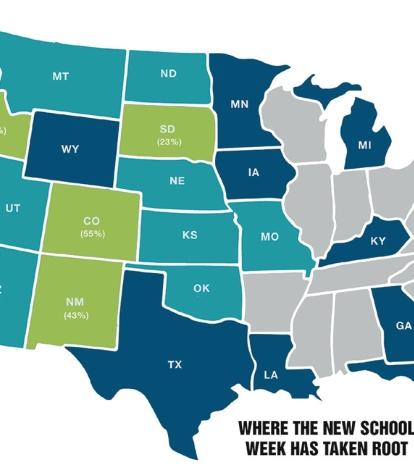Some 560 school districts nationwide have moved to a four-day school week. The move to pack the same number of instructional hours into four days — principally done to save money — has divided school communities.
What is the impact on student achievement? Is it fair to saddle working parents of younger kids with the burden of child care? Does the four-day school week free up time for sports and enrichment activities — or preclude those activities? How much money does the measure actually save?
The limited research on the four-day school week is so far inconclusive on the benefit or harm to student learning. And the cost-savings, researchers have found, often fall short of projections.
The phenomenon, which began in small rural school districts to reduce student commuting time and utility costs, took off after the Great Recession in more populous areas and is now a reality in at least one school district in 25 states across the nation, predominantly in the West.
In Colorado, 98 of the state’s 178 school districts have converted to a four-day week, principally to reduce expenses. Colorado ranks No. 39 among the 50 states and the District of Columbia in per-pupil spending on public education, according to the Census Bureau.
“I realize this will be a significant change for our students, their families, and the communities we are so fortunate to serve, but our district can no longer be expected to do more with less financial resources,” said Superintendent Chris Fiedler, when he announced in March that his northern Colorado school district was switching to a Tuesday-through-Friday schedule starting in August 2018.
Teachers in Douglas County, a wealthier part of the state south of Denver, are bracing for the introduction of a four-day week in the country’s 91 schools if two school-funding initiatives on the ballot in November fail to pass. In addition to crumbling and crowded school buildings, they say, there is a teacher shortage in Douglas County because of low pay.
“It’s disgusting that we have to make such sacrifices to work within the constraints of low funding,” said Palmer Hoegh, a high school math teacher in Douglas County. “A big problem would be child care that parents are going to have to pay. And I’m concerned about students that rely on school for a solid meal. The school is a refuge for them.”
Kendra Gish, who teaches high school geography and history, said her principal told her the Douglas County schools would be shut down on Fridays and after-school programs from band to basketball would have no access to the building.
The longer school day will also be a challenge for students. “We’ll have to be creative about how to keep students engaged,” Gish said. “I can’t see the benefits for the kids.”
In neighboring New Mexico, which ranks 34th in the nation in public school spending, the four-day school week has spread to 38 of the state’s 89 school districts. Those mainly rural districts account for about 5 percent of the state’s 330,00 public school students. State lawmakers concerned about falling test scores placed a moratorium on additional four-day school scheduling in February 2018.
Many New Mexico teachers, however, have embraced the change, and cash-strapped superintendents in rural districts see the four-day week as a recruitment incentive given the job’s low pay.
Betty Patterson, the president of the National Education Association-New Mexico, said the decision to shorten the school week makes sense for rural districts, where students travel an hour or more to school each day.
Michelle Lopez, a 3rd-grade teacher in the town of Jal, New Mexico, near the Texas border, said educators have made the most of the new schedule. “We have extended blocks of time during the week for reading and math interventions for students who need help,” she said. “A lot of us come in on Fridays anyway for lesson plans and other paperwork.”
Kathy Ryan, an English teacher at Cobre HS in Bayard, New Mexico, said that athletes, who in the past did not show up for Friday afternoon classes, have better attendance on the Monday-Thursday schedule and still have access to the school for Friday practices and games.
Patterson, the NEA-New Mexico president, wants her state’s moratorium lifted.
“The state is pushing hard on testing, and they’re concerned about time away from school,” she said. “But testing is not a reason to look at the schedule.”
